Pigg O Stat: Gold Standard for Pediatric Immobilization Devices.
One of the primary concerns of parents as well as medical practitioners when considering radiographic examinations is exposing children to unnecessary radiation.
This is where the industry standard for pediatric immobilization comes in handy:
The Pigg O Stat.
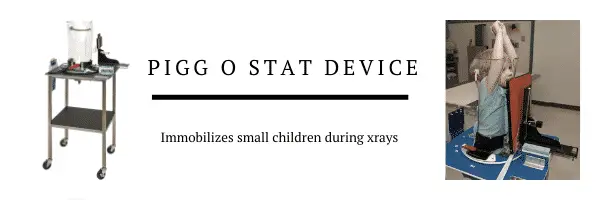
Children and infants require special attention during radiographic evaluations (1).
Pediatric radiographers often use effective communication and immobilization to minimize such risks.
Pigg O Stat: A Rad Tech’s Best Friend
Using an effective pediatric immobilization device to make the radiographic procedure quick is an additional tool in the radiology suite.
It also helps to minimize radiation exposure.
An experienced radiographer knows how to distract and pacify a child using words of praise and reassurance.
When a child is calm and reassured, the baby x-ray procedure can be done effortlessly.
However, a flustered child or a novice radiologic technologist can quickly escalate the situation, and it can be a traumatic experience for both participants.
Aside from a calm tech demeanor and distraction techniques, the next most important tool is the pediatric immobilization device.
The Pigg O Stat is one of the most trusted immobilization devices for pediatrics in the radiology department since the 1960s.
It is the first clinically proven device that reduces radiation exposure to pediatric patients (2).
In this post, we discuss the Pigg-O-Stat at length as well as the importance of child immobilization during a radiographic medical procedure.
Why do babies need x-rays?
X-rays perform on babies when doctors need to find out the reason behind certain illnesses. These include:
- Chest pain and cough
- Enlarged heart
- Digestive problems
- Broken bones
Babies might also need x-rays when doctors need to retrieve a swallowed solid object.
Babies are known for swallowing coins, paper clips and anything they can put in their mouths.
Another reason why babies need x-ray procedures is to determine that the medical tubes are placed in the right location and position after a medical procedure.
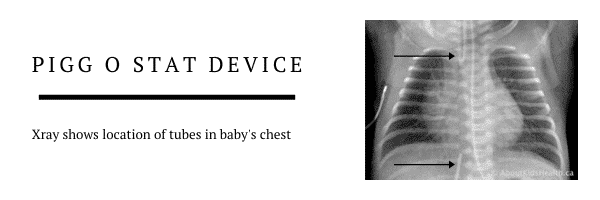
If abuse is suspected, x-rays can be used to evaluate old and new fractures.
I wrote about this in a forensic radiology article a few months ago (source).
What are devices used to hold babies motionless for x-rays?
- Positioning sponges, sandbags & velcro straps
- Pedia-poser
- Infantainers / child huggers / papoose
- Pigg O Stat pediatric immobilizer
- Octagonal infant immobilizer
Babies and toddlers are not known for staying still for more than a couple of seconds.
But movements during an x-ray procedure can result in blurry images.
A clear diagnostic x-ray image will help the physicians to determine the underlying cause of the illness.
Although technologists allow parents into the x-ray examination room with the child, it is neither safe nor practical to hold a child during the procedure.
If radiologic technologists have to hold the baby, they also risk exposure to radiation.
This is why having effective immobilization devices becomes an absolute necessity.
In pediatric radiology, the most common ways employed to hold the child still for x-rays includes:
- Positioning sponges and sandbags – These are the simplest immobilizing techniques. They restrict the motion of the baby or a toddler. The technologist can employ these techniques, when the young patient needs to be x-rayed on a limb and when the procedure needs to be done lying down.
Positioning sponges designs to support a part of the body, such as the limbs or the head.
They also reduce the strain caused by holding the body or an arm in one position for an extended period.
They come in a variety of sizes and shapes are also widely available.

Sandbags
Sandbags come in very handy when the patient cannot hold still, either due to anxiety or restlessness.
When a baby is particularly restless, placing a sandbag on his or her arm can help reduce the movement.
- Velcro straps – These are also simple but effective ways to help a child be still for X-rays, especially if the procedure needs to be conducted on the limbs and extremities.
It is best to use disposable straps or vinyl-coated to make cleaning them easy.
- Pedia-poser is a device with a chair, an abdomen strap, a chin strap, and shoulder straps. The seat can be adjusted to suit toddlers and children up to 4 years of age by raising the chair up and down. Since the child is strapped in and the chin is held up, it can be used for the chest and x-rays on the abdomen.
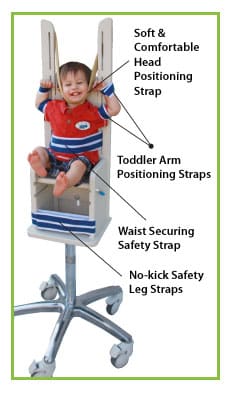
Strapping a child into the device it is not the most aesthetically pleasing, but it gently secures the baby patients for a safe x-ray procedure.
- Infantainers/child huggers – These devices go by names such as child huggers, infantainers, mummy wraps, and papooses. These are used for swaddling the little patients so they remain still for x-ray imaging.
Although restraining the child in one of these may look uncomfortable, they are safe and comfortable.
They are typically made of contoured soft foam and Plexiglas.
These are also used to facilitate the transportation of patients in case of an accident.
- Pigg O Stat – Beloved by radiologic technologists and doctors, this is the “Gold Standard” of all pediatric immobilization devices. Gold Standard is a label given in healthcare to a device or protocol widely used as the best source. Convenient and easy to use, it can be used for imaging patients from infants to children up to 3 years.
- Octagonal infant immobilization cradle – Although not very common, it is a great technique when there is no assistance in the X-ray room. Here the child’s arm and head are immobilized, which allows the technologist to take images in different positions.
What is a pediatric immobilization device?
- A pediatric immobilization device is a piece of medical equipment that restricts the patients’ movements and keeps them still for a medical procedure such as an X-ray.
Many different types of pediatric immobilization devices and common hospital items can gently hold a pediatric patient motionless during imaging.
This includes:
- Positioning sponges or bookends
- Adhesive tapes
- Sandbags
- Towels and sheets
- Velcro compression bands
- Ace bandages
- Radiolucent sponge blocks
- Papooses, Mummy wraps
- Infantainers, child huggers
- Head clamps
- Velcro strap restraints
- Pedia poser
- Pigg-O-Stat
- Octagonal infant immobilization cradle
These devices not only assist in keeping the patient’s still but also enable technologists to produce the best results in imaging.
They reduce the time required for the procedure and ultimately, reduce the exposure to radiation.
What is a Pigg O Stat?
- Pigg O Stat is an innovative pediatric immobilization device that is exclusively designed to hold infants while undergoing x-ray imaging.
- The components of the Pigg O Stat immobilizer make this an all-in-one device that is easy to use and convenient.
- You can reach the makers of this device by calling 1-931-676-5274.
This pediatric immobilization device comes in two variations – analog and digital.
Given that this piece of equipment is plastic and metal, I wasn’t sure what could be “analog and digital” about it.
So I called the company.
I found out the “analog” version has a cassette holder attached to the immobilizer itself.
Of course, this can also be used to hold a digital receptor as well.
But the “digital” version of the Pigg-O-Stat has no holding mechanism at all.
If you own the digital version, you simply have to push the immobilizer up against your wall bucky or other means of a receptor holder, unattached to the Pigg-O-Stat.
Why is the Pigg O Stat an industry favorite?
The reason why Pigg O Stat has become a favorite of technologists and doctors is that it was the first clinically proven device that reduces exposure to radiation.
The reduction of exposure is due to the fact that it greatly eliminates the need to repeat xrays due to uncooperative pediatric patients.
You sit the patient inside the device, strap them in for immobilization and capture the image.
There are no electronic parts that can fail.
The x-ray images produced with the help of a Pigg O Stat are high-quality, which facilitates the overall treatment of the patients.
The device is made of highly durable and sturdy components.
It comes with a one year warranty for defective parts from the manufacturer.
The Pigg O Stat Pediatric Foot Immobilizer
There is another Pigg-O-Stat device called the Pediatric Foot Immobilizer.
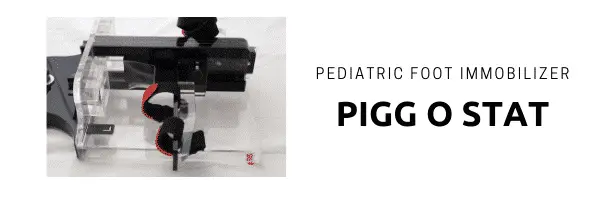
It is a separate component from the original immobilization device.
However, it is used to immobilize the feet of the patients during an x-ray.
The feet of the babies are strapped into the Plexiglas plates, and the children are kept more secure during the procedure.
The Pigg-O-Stat pediatric foot immobilizer was introduced at a later date than the pediatric immobilization device.
But they are manufactured by the same company. It is also made of durable and sturdy material for best performance as well as longevity.
The device is approved by pediatricians.
Both the Pigg-O-Stat devices are easy to use, and maintenance is straightforward.
To sterilize the device, Zephiran Chloride is recommended for both the immobilizers while the Plexiglas may be cleaned with soapy water and a soft cloth.
It is important to sterilize the devices after each use.
The moving parts, as well as the hardware, can be oiled frequently for smooth operation.
Who is the Pigg O Stat inventor?
- The Pigg-O-Stat was invented by an x-ray technologist named Jalmer Pigg, Sr. on August 28, 1962.
The device was named after him. According to data, he patented the device as can be seen here.
Mr. Pigg realized that the immobilizers common at the time still required an assistant to stay in the room with the patient during the exposure.
Knowing this was unacceptable from an occupational exposure perspective, he developed the Pigg-O-Stat.
It allows practitioners to leave the patient’s side and resume the exam at the control station.
This eliminates unnecessary radiation for the healthcare worker.
What is the history of Pigg O Stat ?
The history of Pigg-O-Stat dates to the 1960s when Jalmer Pigg, Sr. felt the need for accurate x-ray imaging for squirming infants and children in general.
Mr. Pigg was an x-ray technician at Memphis, Tennessee in the US.

Prior to the invention of the Pigg-O-Stat, the default x-ray device was called Dunn positioner.
It was a device for children that was invented by Robert G Dunn in 1952.
Although it supported children during the x-ray imaging in a seated position, it was not the most ideal or comfortable.
Mr. Pigg Sr. was always concerned about the fact that a child needs to be held during the x-ray procedure.
This not only exposes the parents or the technologists holding the baby to radiation, but it also was not convenient.
Understanding the critical role of clear x-ray imaging in diagnosing young patients was not lost on him. His patent application emphasized the Pigg-O-Stat as an enhancement to existing technologies for properly positioning infants throughout the duration of x-ray procedures.
He successfully refined multiple elements of the Pigg-O-Stat, and his efforts culminated in the granting of the patent on August 28, 1962, a couple of years post submission.
The Pigg-O-Stat has gradually become one of the most favored pediatric immobilizer devices this century.
The Pigg O Stat is still used today. In fact, I haven’t worked at a hospital in my 20 years of service that didn’t have one.
What are the Pigg-O-Stat uses?
The Pigg-O-Stat is an immobilizer device that is exclusively used to hold infants and children motionless while undergoing an x-ray.
The device is used to improve the quality of the x-ray imaging and also to reduce exposure of the patients as well as the radiologic technologists to radiation. It also reduces the time taken to complete the x-ray procedure.
What are the alternatives to Pigg-O-Stat?
The Pigg-O-Stat is the gold standard for pediatric immobilization devices.
The images produced using the device are still among the best, and many radiologists prefer to use it.
However, if in any case, strapping the child into the device does not seem comfortable or possible, there are other alternative immobilizer devices that can be used. They are:
- Bookends for abdominal x-rays
- Positioning sponges, straps and sandbags for the limbs
- Mummy wraps, child huggers and swaddling devices like a papoose board
- Velcro strap restraints
- Towels and sheets
What is a papoose board?
- It is a stabilization board in the medical field used to restrict the movements of the patient during a medical procedure.
- They are also known as cradleboards, and they trace their origins to the Native American tribes.
In pediatric radiology, it is used to temporarily immobilize children for completing the x-ray.
The board is made of non-metal components, so it does not affect the efficacy of the x-ray results or other diagnostic imaging.
It is also used in dental procedures or for transporting a patient in case of accidents.
A papoose board is also used for children with special needs.
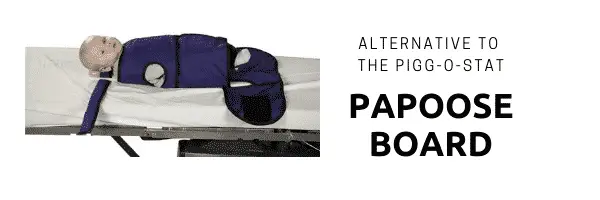
The papoose board is very easy to use and is one of the most preferred immobilizing methods for infants who cannot sit up on their own and uncooperative children.
Using the device can be efficiently performed in less than 60 seconds.
The board is made of lightweight radiolucent material which is latex-free.
The shape of the board, which is elongated, makes the flaps easily crisscross around the patient.
It includes a padded flap set which are three in number, a padded head strap and four straps for the arms/hands.
The board also has a hole in the top for easy storage when not in use.
Conclusion.
The safety of children is a top priority for both parents and caregivers.
Ironically, the place where the children receive treatment is also where they get exposed to radiation using radiographic examination.
However, through the use of a sophisticated pediatric immobilization device like the pigg-o-stat, radiation exposure can be significantly reduced.
It also eliminates the need for parents and radiologic technologists to be baby X-ray holders.
This, in turn, reduces the chance of exposure to adults. Repeat exams are reduced significantly.
Many factors may justify using restraints for a pediatric patient: medical necessity, patient safety, clinician safety, and exam expediency.
This pediatric immobilization device is easy to set up, and using it is efficient. It is also a great help when there is no assistance around.
But perhaps the best feature about the Pigg-O-Stat is yielding great quality X-ray pictures while virtually eliminating the need to repeat images due to a fussy patient.
It is no wonder that it has been the most trusted pediatric immobilization device by rad techs, doctors, and clinics worldwide for more than half a century.
Resources
- Safety Considerations in Immobilizing Pediatric Clients for Radiographic Procedures. (2017, February 16). Retrieved from https://www.sciencedirect.com/science/article/abs/pii/S154608431630030X
2. Imaging Children: Tips and Tricks. (2007, February 20). Retrieved from https://www.sciencedirect.com/science/article/abs/pii/S1546084307000089
3. Sharko, G. A., & Wilmot, D. M. (1987). Radiography of the Chest and Upper Airway. Pediatric Imaging for the Technologist, 27–38. doi: 10.1007/978-1-4612-4690-9_4
4. Ng, J. H. S., & Doyle, E. (2019). Keeping Children Still in Medical Imaging Examinations- Immobilisation or Restraint: A Literature Review. Journal of Medical Imaging and Radiation Sciences, 50(1), 179–187. doi: 10.1016/j.jmir.2018.09.008

